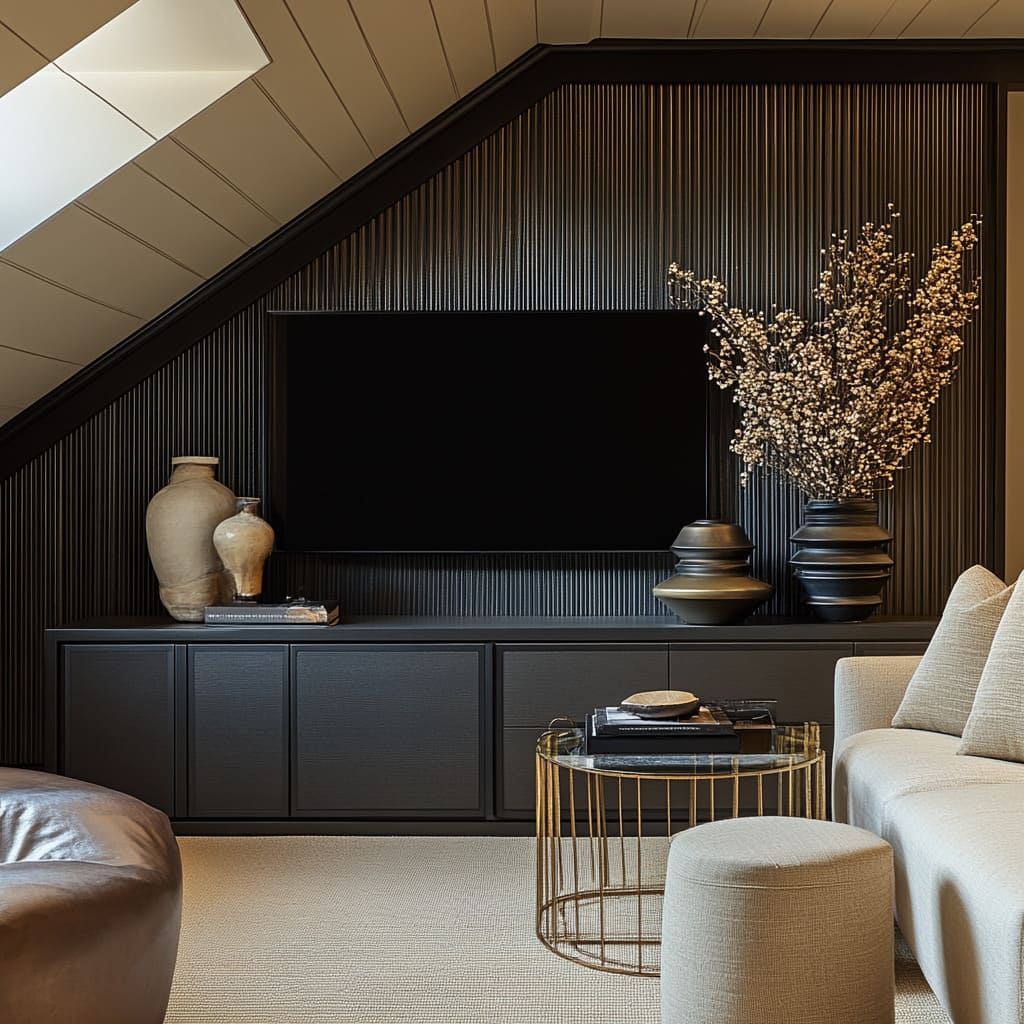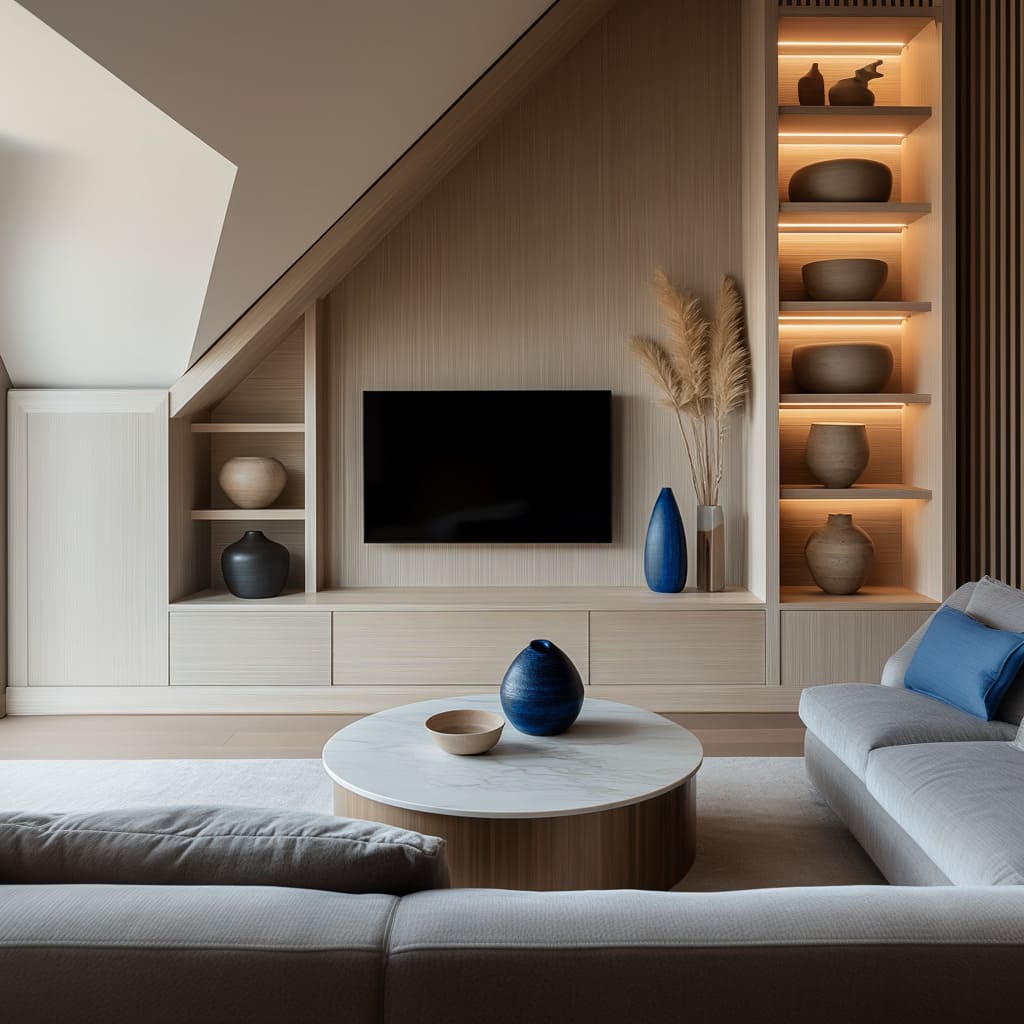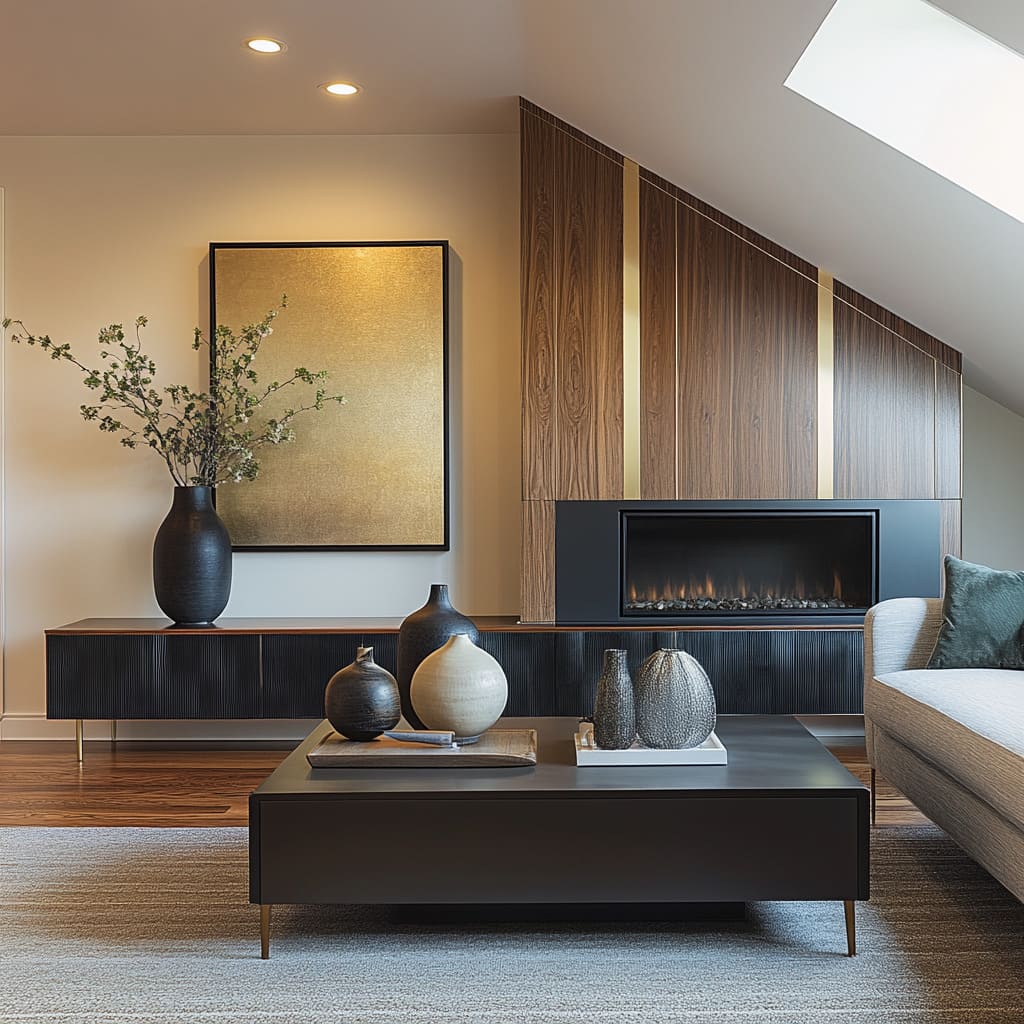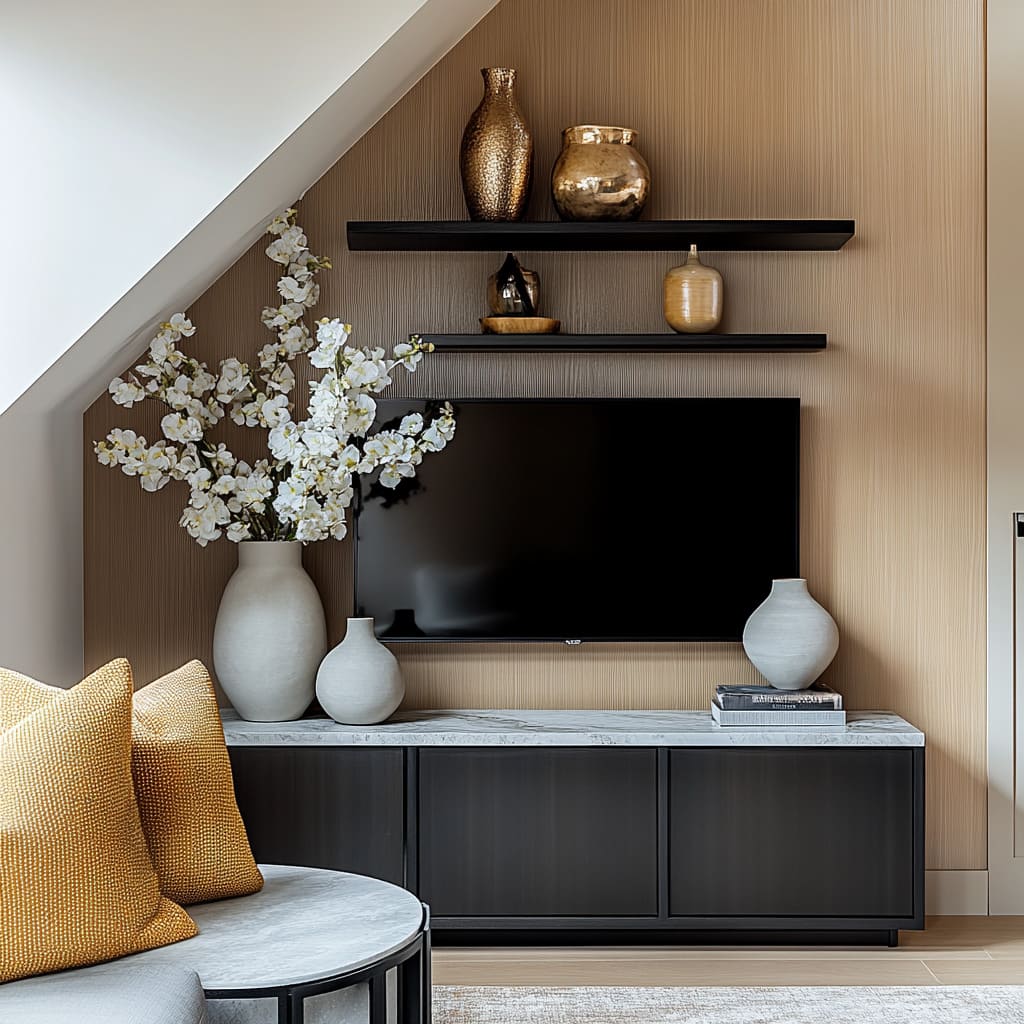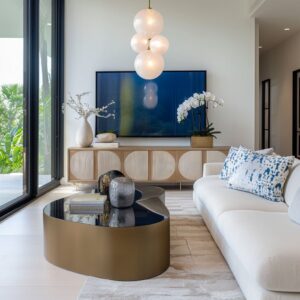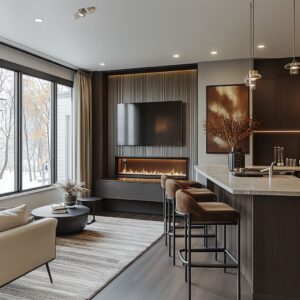Transforming an attic into a modern living room requires a keen understanding of architecture, furniture design, and decor choices to create a functional yet visually captivating space. Attics present unique challenges and opportunities due to their ceiling slopes, compact dimensions, and natural light variations.
Drawing on the detailed descriptions analyzed in this chat, this article provides a comprehensive guide to designing and decorating modern attic living rooms, including architectural features, furniture choices, finishes, lighting, and decor strategies.
Working with Attic Architecture and Ceiling Features
Attic living rooms are often shaped by their distinctive sloped ceilings and angled walls, which bring character and uniqueness to a space that is often overlooked. These features may appear limiting at first, but with the right design approach, they transform into striking architectural highlights.
Whether you are dealing with vaulted, gabled, or arched ceilings, the goal is to embrace their structure, not fight against it. Here’s how to make those ceiling features shine while creating a functional and visually stunning lofted living room.
Ceiling Treatments: Enhancing Architectural Character
The ceiling is the crown of any attic living space, and treating it as such makes all the difference. Wooden cladding is one of the most effective treatments for adding warmth and texture.
Light-toned wood panels—whether smooth or lightly ridged—help create an airy, cozy atmosphere. For homeowners who prefer a brighter and more minimal look, painted white planks are an excellent choice.
White reflects natural and artificial light, amplifying the feeling of openness even when ceilings are low or steeply sloped. Vaulted ceilings particularly benefit from horizontal or diagonal paneling.
These patterns elongate the room visually, drawing the eye upward and accentuating the ceiling’s angles. Similarly, tongue-and-groove wood finishes bring in subtle detail without overwhelming the design.
The natural grain of the wood complements neutral color palettes, while painted finishes pair beautifully with contemporary decor.
Lighting Integration: Accentuating Angles and Adding Depth
Lighting plays a transformative role in attic living rooms, especially when dealing with sloped ceilings that can create shadowy corners. One popular approach is recessed LED strip lighting installed along the edges of the ceiling slopes.
This design not only adds soft, ambient illumination but also highlights the angles of the ceiling, turning them into design features rather than obstacles. The warm glow of these lights enhances the overall coziness, making the space feel inviting during the evening hours.
Skylights are another critical addition for attic living room ideas. Positioned strategically along the steepest part of the ceiling, they flood the room with natural light, creating a balance between brightness and intimacy.
Skylights also provide a connection to the outdoors, allowing sunlight to bounce across the ceiling’s textures and patterns. For added flair, consider skylights with integrated blinds to control light intensity.
Pendant lights or small chandeliers are an excellent way to punctuate the center of a vaulted or gabled ceiling. Opt for fixtures with clean lines and minimal designs to avoid overwhelming the room.
Meanwhile, wall sconces placed along the highest points of sloped walls can add focused light while emphasizing the unique architecture.
Architectural Focus: Creating Harmony Between Walls and Ceilings
The ceiling sets the tone for the room, but the walls act as its supporting canvas. To create a seamless flow between the two, wall finishes must complement the ceiling treatments.
One of the best ways to achieve this is through textured wall claddings such as stone, wooden panels, or vertical grooves. Vertical paneling, in particular, draws the eye upward, extending the sense of height and creating a natural connection between the walls and the slopes above.
For feature walls—such as those housing a TV or a decorative display—stone finishes or ridged wooden cladding add subtle texture while grounding the space. Neutral shades like light greys, beige, or warm white work best as they prevent the room from feeling heavy or overcrowded.
Incorporating built-in shelving or cabinetry on these walls also helps utilize awkward spaces under slopes. These built-ins can be designed to blend seamlessly with the wall cladding for a streamlined, cohesive look.
When planning a lofted living room, it’s also important to highlight symmetry. Aligning furniture layouts or decorative features along the natural lines of the ceiling enhances the balance of the room, making sloped walls feel intentional rather than restrictive.
Embracing Natural Angles: Architectural Details that Shine
The key to designing a beautiful attic space lies in working with its natural architecture rather than trying to hide its quirks. Angled walls, exposed beams, and dramatic ceiling slopes can all become standout design elements when approached creatively.
For example, leaving beams exposed and painting them in a contrasting shade brings rustic charm to a modern room, while minimal trims add polish without distraction. Additionally, positioning seating or accent furniture to align with sloped ceilings avoids awkward negative spaces.
For areas where the ceiling meets the wall at a low point, low-profile furniture such as benches, ottomans, or custom cabinetry can transform underutilized corners into functional spots for storage or display. By celebrating the unique angles and slopes of attic ceilings, the space becomes an architectural showcase rather than a design challenge.
Combining thoughtful ceiling treatments, integrated lighting, and complementary wall finishes ensures the attic retains its character while feeling polished and cohesive. Whether you’re aiming for a cozy retreat or a modern family gathering area, the right design approach will bring out the best in your attic living space.
Furniture Selection and Layout for Attic Living Rooms
Choosing furniture for attic living rooms requires a careful blend of form and function to suit the room’s unique proportions. The challenge lies in working with angled walls, sloped ceilings, and compact dimensions while ensuring the layout feels open, purposeful, and comfortable.
Compact, versatile pieces and smart placement are key to creating a balanced and inviting space.
Seating Arrangements: Perfecting Comfort and Scale
Attic spaces thrive on furniture that respects their architectural quirks. Sofas with clean lines or curved edges are excellent choices as they fit snugly under sloped ceilings and gabled walls without overwhelming the room.
L-shaped sectionals, in particular, are a go-to solution for attic living rooms as they anchor corners and provide ample seating while maximizing space. Neutral tones like soft white, warm beige, and light grey work wonders for upholstery, making the room feel open and airy—ideal for spaces with low ceilings or minimal natural light.
To inject personality, add cushions in deep, grounding colors such as navy blue or mustard yellow. These small accents create contrast and bring vibrancy without overpowering the clean, modern aesthetic of the room.
In terms of texture, woven fabrics, soft linens, and subtle velvets work beautifully in attic living spaces, enhancing comfort while staying visually understated. For smaller spaces, compact armchairs or curved settees paired with poufs can act as flexible seating options.
These pieces adapt easily to awkward corners, ensuring every inch of the attic is put to good use while keeping the overall layout uncluttered.
Coffee Tables: The Anchor of the Space
The coffee table serves as the centerpiece of any living room layout, and in attics, it softens the lines of the surrounding architecture. Rounded tables are a particularly smart choice as they counterbalance the sharp angles of sloped ceilings and walls.
Options with wooden finishes bring warmth, while marble-topped designs add a sense of refinement and luxury. Black coffee tables are a standout choice, offering a bold contrast against neutral sofas and bright walls.
Their grounding presence visually balances the room, especially in spaces where lighter palettes dominate. If space is limited, opt for nesting tables or smaller round side tables that offer flexibility and can be rearranged as needed.
The key to selecting a coffee table lies in its proportions. It should anchor the seating arrangement without obstructing pathways or overwhelming the room.
Placing a soft area rug beneath the coffee table further defines the space, creating a cozy zone that complements the seating layout.
Built-in Furniture: Optimizing Space with Custom Solutions
Attic living rooms often feature challenging nooks and low wall heights, making built-in furniture a game-changer for functionality and style. Custom-built media units are particularly popular for attic entertainment rooms, as they sit low against sloped walls and seamlessly integrate into the architecture.
These units often incorporate closed cabinetry for hidden storage, open shelving for decorative displays, and recessed spaces for televisions. To enhance the visual appeal of built-in media walls, shelves can be designed with subtle LED lighting.
This adds depth, highlights decorative pieces, and creates a warm, ambient glow—perfect for evening lounging. Vertical shelving units or open niches framing the TV provide balance while offering additional space for books, plants, or curated decor.
Custom benches or storage units fitted under sloped walls are another clever way to optimize unused areas. These pieces serve a dual purpose—offering additional seating and much-needed storage for blankets, board games, or seasonal items.
The finishes for built-in furniture are often chosen to match or complement wall claddings, ensuring harmony across the room. Light woods, matte whites, or soft greys work well to keep the overall look cohesive.
Furniture Placement: Maximizing Layout and Flow
Furniture placement in an attic living room is all about making the most of the available space without compromising comfort. The central seating arrangement often acts as the heart of the room, with sofas or sectionals facing the main feature—whether it’s a TV, a fireplace, or a textured accent wall.
By centralizing the seating, the room achieves a sense of balance while avoiding clutter near the edges where ceilings drop lower. To ensure the space doesn’t feel cramped, position the tallest pieces of furniture—such as bookcases or shelving units—where the ceiling reaches its peak.
This creates vertical balance and draws attention upward, making the room appear taller. At the same time, keep bulkier pieces like low-profile sofas and coffee tables toward the middle of the room to allow for easy movement.
Awkward corners or areas where ceilings slope too low can be transformed into functional zones with smart furniture choices. A built-in bench, an ottoman, or even a reading nook with cozy cushions and soft lighting adds purpose to otherwise unused spaces.
For those exploring attic sitting room ideas, placing armchairs with a side table near a skylight can turn a corner into a relaxing spot for reading or morning coffee. When arranging furniture, ensure there’s ample room to move freely throughout the space.
Leave open pathways between major pieces, and avoid blocking windows or light sources. A layout that feels natural and uncluttered will make even the smallest attic living room feel welcoming and well-thought-out.
By carefully selecting proportionate furniture, integrating built-in solutions, and maintaining a strategic layout, an attic living room transforms into a functional yet stylish retreat. From the grounding presence of a marble coffee table to the versatility of a well-placed L-shaped sectional, each piece works in harmony with the room’s unique architecture.
Thoughtful choices ensure every nook and cranny is utilized effectively, creating a space that’s not only practical but visually engaging.
Finishes, Wall Treatments, and Flooring
The finishes and materials chosen for an attic living room are fundamental to creating a cohesive and stylish space. These elements work together to highlight the architectural charm of the sloped ceilings while maintaining a sense of warmth and openness.
Thoughtful selections ensure the room feels inviting without losing its modern edge, making it a standout design within the home.
Wall Finishes: Balancing Texture and Light
Walls in a modern attic living room serve as the canvas for setting the tone of the space. Smooth paint finishes in soft whites, creams, and light greys are ideal for keeping the room bright and visually expansive.
These lighter tones reflect both natural and artificial light, making the attic appear larger and airier—a much-needed quality for spaces that often contend with lower ceilings. To introduce subtle contrast, textured wall treatments are used strategically.
For example, a feature wall behind the TV can incorporate stone cladding or large-scale tiles that bring depth and a tactile element. This addition works particularly well in attic entertainment rooms, where a focal point enhances the overall design.
Another popular treatment is vertical wood paneling or shiplap, which draws the eye upward and accentuates the height of vaulted ceilings. The warmth of natural wood tones juxtaposed against smooth painted surfaces creates a balanced, contemporary atmosphere.
Wall claddings also play a role in connecting various zones of the attic living space. Incorporating these finishes behind built-in shelves or media units helps blend functional furniture with architectural features.
In smaller spaces, sticking to uniform finishes prevents visual clutter, while in larger attics, mixing textures like light wood and matte stone adds depth without overwhelming the space.
Ceiling Finishes: Highlighting the Architecture
The ceiling is one of the defining features of an attic living room, and how it is finished can transform the space entirely. Vaulted ceilings often receive light-toned wooden planks or smooth white panels, both of which highlight the structure’s charm while maintaining a bright and airy aesthetic.
These finishes allow sloped ceilings to feel intentional rather than restrictive, reinforcing the architectural character of the attic. In cozy attic living rooms, exposed beams or ridged ceiling details are popular for adding texture and interest.
Wooden beams—either left natural or painted to match the ceiling—can visually divide the space without adding bulk, while ridged finishes or tongue-and-groove panels lend a refined, modern touch. This approach creates a layered look that keeps the design engaging without detracting from the overall simplicity.
For rooms with steeply sloped ceilings, lighter finishes are key to avoiding a cave-like feeling. Painting the ceiling white or soft grey helps bounce light and visually expands the room.
When paired with darker wall finishes or accents, this contrast creates a sophisticated yet welcoming environment. Skylights incorporated into the ceiling design further enhance its role, offering natural illumination and turning the ceiling itself into a standout feature.
Flooring: Grounding the Design with Warmth and Comfort
Flooring in attic living rooms ties the space together and balances the vertical elements introduced by sloped walls and ceilings. Light wood plank flooring is the most popular choice for modern attic spaces, as it adds natural warmth and pairs effortlessly with other finishes.
The pale tones of oak or maple floors create a harmonious connection with wood-clad ceilings, ensuring a unified and relaxed design. To soften the flooring and define specific zones, area rugs are an essential addition.
A neutral-toned rug—think beige, cream, or light grey—works beautifully beneath seating areas to create a cozy attic living room atmosphere. These rugs add warmth underfoot and provide visual grounding for furniture layouts, helping the room feel more intentional and inviting.
Textured rugs, such as those made from woven wool or jute, can introduce subtle pattern and dimension, complementing both contemporary and rustic styles. In attic spaces that serve multiple purposes, flooring transitions can be used to separate areas without physical barriers.
For example, a textured rug under the main seating area and a smooth wooden floor in adjoining zones maintain continuity while creating subtle definition. This approach works particularly well for attic living space ideas where an open layout is prioritized.
Window Placement: Enhancing Light and Airflow
Windows are a critical consideration in attic living rooms, as their placement directly influences both the functionality and aesthetic of the space. Skylights are a practical solution for sloped ceilings, flooding the room with natural light while preserving wall space for furniture or decor.
They brighten the uppermost parts of the room, ensuring even the darkest corners feel open and welcoming. In smaller attics, strategically placed skylights make the ceiling appear taller, adding vertical space without structural changes.
On side walls, vertical windows play an equally important role. Large, narrow windows framed in simple finishes allow natural light to enter without overwhelming the proportions of the room.
These windows also provide external views, helping to open up the space visually and reduce the sense of enclosure. Additionally, their placement can improve ventilation, a significant benefit for loft living room furniture arrangements where airflow may otherwise feel restricted.
Combining skylights with side windows creates a dynamic balance of light sources. This strategy works particularly well in larger attic living spaces, where the mix of natural light from multiple angles prevents shadows and creates a more open feel.
Adding sheer curtains or soft blinds to vertical windows ensures privacy without sacrificing light, while maintaining a clean, modern look that complements the overall design. By blending light-reflective wall finishes, thoughtfully treated ceilings, and warm, grounding floors, an attic living room achieves a sense of harmony and style.
Clever window placements bring life to the space, balancing natural light with architectural features. Together, these elements transform the attic into a functional and visually stunning living area that feels both modern and inviting.
Decor and Accessories for Cohesion
Decor is the finishing touch that transforms an attic living room from a functional space into one filled with character and charm. Thoughtfully selected accessories, textures, and accents work in harmony to highlight the architectural features of the attic while keeping the design refined and intentional.
These choices bring warmth and style, ensuring the space feels personal and welcoming without compromising its clean aesthetic.
Decorative Accents: Adding Layers of Interest
Decorative accents in modern attic living spaces play a pivotal role in balancing simplicity with visual richness. Sculptural vases, ceramic vessels, and artisanal items in neutral palettes, soft blues, and natural tones act as understated yet impactful additions.
Placing these accents strategically on shelves, console tables, and coffee tables adds visual texture while keeping the room uncluttered. For instance, pairing a matte ceramic vase with dried branches on a round coffee table creates a natural, grounded focal point.
In built-in shelving or display niches, sculptural items in varying heights add dimension. Combining materials—such as a mix of wood, stone, and glass—ensures the decor feels layered and cohesive.
In an attic living room decorating ideas approach, soft metallic finishes like brushed gold or black accents can tie the room together, offering contrast without overwhelming the design. Decorative books, textured bowls, and small sculptures also work beautifully to fill negative spaces, adding subtle details that make the room feel curated.
Shelving and Niches: Functional Displays with Style
Built-in shelves and recessed niches are key features in many attic living rooms, as they maximize storage and decor opportunities without sacrificing floor space. Positioned on either side of the TV or media wall, these shelves create symmetry while offering a place to display carefully selected items.
Recessed LED lighting is often installed within these shelves to highlight decor pieces and provide a soft, ambient glow. For a balanced and visually appealing display, grouping items in threes or odd numbers creates a natural flow.
A large sculptural vase on the top shelf, paired with smaller decorative items on lower levels, draws the eye downward while maintaining proportion. Open shelving also offers a chance to incorporate seasonal decor or personal items, allowing the living room in attic spaces to feel lived-in yet organized.
The finishes of shelving matter just as much as the items displayed. Wooden shelves in light oak or white finishes integrate seamlessly into modern attic spaces, complementing the natural materials seen in floors and ceilings.
When paired with soft LED backlighting, these shelves transform into subtle design features that elevate the overall aesthetic of the room.
Soft Textiles: Comfort and Color Without Overload
Textiles bring softness and warmth to the living room and help counter the architectural edges of an attic’s sloped ceilings. Layering plush cushions and cozy throws on sofas not only enhances comfort but also introduces subtle bursts of color.
Deep navy, mustard yellow, and muted green tones work particularly well against neutral upholstery like cream, grey, or beige, adding contrast without disrupting the room’s calm atmosphere. To create a cohesive look, cushions in varying textures—such as linen, velvet, or woven fabrics—are ideal.
Mixing a large cushion with a couple of smaller ones creates visual balance, while throws casually draped over armrests or folded on the sofa introduce a lived-in touch. For an extra cozy attic living room vibe, soft area rugs with textured patterns or thick weaves anchor the seating area, tying the furniture and decor together while offering warmth underfoot.
Greenery and Artwork: Bringing Life and Focus
Introducing greenery into an attic living room instantly breathes life into the space. Small potted plants on shelves or console tables soften the room’s angular lines, while taller branches in sculptural vases make an organic statement without taking up too much space.
Greenery complements natural finishes like wood and stone, reinforcing an earthy, relaxed aesthetic. Low-maintenance options such as dried pampas grass or faux plants are perfect for homeowners seeking a hassle-free touch of nature.
Artwork further personalizes the attic space, acting as a focal point while connecting the decor with surrounding finishes. Abstract paintings with hints of gold, black, or stone textures work beautifully in modern attic designs, adding depth without competing with architectural details.
A large framed artwork placed above a media unit or leaned against a side wall introduces vertical interest, balancing the proportions of a sloped ceiling. Subtle use of black frames or natural wood borders ties the artwork to other elements in the room, ensuring harmony.
By thoughtfully combining sculptural accents, layered textiles, greenery, and striking artwork, attic living spaces can achieve a perfect blend of comfort and sophistication. Every decorative element serves a purpose, enhancing the room’s personality while staying true to its architectural charm.
Whether designing an attic sitting room or a compact living room in attic spaces, these details ensure the design feels curated, cohesive, and effortlessly inviting.
Lighting Design for Attic Ceilings and Interiors
Lighting in attic living rooms requires a well-thought-out plan to overcome the challenges presented by sloped ceilings, limited headspace, and unique architectural angles. A carefully designed lighting scheme not only illuminates the space effectively but also enhances the visual appeal of the room.
It balances functionality with aesthetics to make the attic inviting and comfortable throughout the day and evening.
Indirect Ceiling Lighting: Highlighting the Architecture
Indirect ceiling lighting is a game-changer for attic spaces, particularly when it comes to sloped or vaulted ceilings. LED strip lights installed along the edges of beams or the meeting points of sloped surfaces add a soft, ambient glow that beautifully highlights the ceiling’s unique angles.
This method eliminates dark or shadowy corners while emphasizing the architecture, creating a visually expansive feel. The subtle glow does not overpower the space and works well with a variety of finishes, from white-paneled ceilings to natural wood planks.
To further elevate the design, homeowners can use dimmable LEDs, allowing the light intensity to adapt to the time of day. For instance, bright indirect light during the day enhances a sense of openness, while dimmer settings in the evening offer a warm, relaxed ambiance.
By aligning the lighting layout with the ceiling structure, even the smallest attic family room ideas can transform into beautifully lit retreats.
Task Lighting: Focused and Functional Illumination
Task lighting in attic living rooms serves both practical and decorative purposes. Adjustable wall sconces mounted along sloped walls or within nooks provide targeted illumination for activities like reading, working, or simply unwinding.
These sleek fixtures take up minimal space, which is ideal for compact areas where floor or table space is limited. Incorporating modern table lamps on side tables or media units adds both style and functionality to the living room.
Designs with clean lines and metallic finishes complement contemporary attic interiors while offering focused light where needed. Task lighting ensures the room remains functional without compromising the overall aesthetic, blending seamlessly with the seating arrangement and decor.
Accent Lighting: Highlighting Decorative Features
Accent lighting plays a significant role in bringing depth and dimension to attic interiors. Built-in shelves, niches, or display units benefit greatly from recessed LED lights.
These lights not only highlight decor items like vases, books, and sculptures but also create a soft visual rhythm throughout the room. By using warm-toned bulbs, the lighting complements natural materials such as wood and stone, enhancing the cozy atmosphere of the space.
Additionally, strategically placed spotlights can illuminate textured feature walls, such as vertical wood paneling or stone cladding, further emphasizing the design details. Accent lighting introduces layers to the overall lighting scheme, creating interest and balancing ambient and task light sources.
For attic living rooms designed with minimalistic decor, accent lighting brings focus to carefully curated pieces without overwhelming the layout.
Natural Light: Bright and Balanced Illumination
Attic living spaces thrive on natural light, and window placement plays a crucial role in achieving this balance. Skylights installed on sloped ceilings allow sunlight to flood the upper areas of the room, eliminating dark zones and enhancing the sense of openness.
They are particularly effective in modern attic living rooms, where natural light reflects off light-colored walls, ceilings, and floors to create a bright, airy ambiance.
Complementing skylights, vertical windows on side walls add a connection to the outdoors and introduce secondary light sources. These windows reduce the reliance on artificial lighting during the day and allow for cross-ventilation.
Proper window treatments, like sheer curtains or sleek blinds, maintain privacy while diffusing the light for a soft glow. Combining natural light with layered artificial lighting ensures the attic space feels balanced, welcoming, and functional.
When thoughtfully designed, lighting transforms attic living rooms into sophisticated and functional spaces. By combining indirect ceiling lighting, focused task illumination, accent highlights, and ample natural light, homeowners can emphasize the architectural beauty of their attic interiors while maintaining comfort and usability.
Whether you’re designing a compact entertainment area or seeking attic family room ideas, an effective lighting strategy ensures every corner of the space feels intentional, balanced, and beautifully lit.
Conclusion
Designing a modern attic living room requires thoughtful integration of architecture, furniture, finishes, and lighting. The sloped ceiling, while challenging, serves as a defining feature that can be enhanced with strategic design choices such as wooden cladding, recessed lighting, and carefully curated decor.
Built-in furniture, including low-profile media units and open shelving, maximizes space while maintaining a clean, modern aesthetic. Thoughtfully chosen finishes, such as textured wall treatments, light wood floors, and neutral upholstery, work together to create a cohesive and inviting environment.
By layering lighting, balancing furniture placement, and incorporating small decorative accents, attic living rooms transform into functional, stylish retreats that celebrate their unique architecture. The combination of natural and artificial light ensures the space remains bright and livable, while decor choices bring warmth, texture, and character.
Each element—from the vaulted ceiling to the smallest ceramic vase—plays a role in creating a harmonious, modern attic living room.



